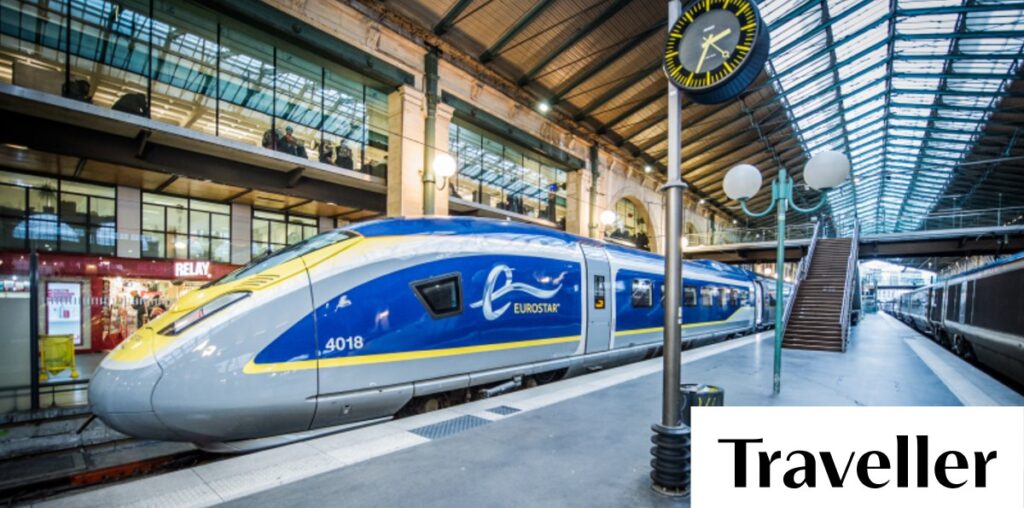Boarding, like the Irish Sea this morning, is smooth. We present printed seat reservations and our digital pass after reminding each other to link the preloaded ferry trip to it with a simple toggle in the Railplanner app.
We do this again two hours and 15 minutes later when we dock at Cairnryan where, hopefully, bus number 923 will be waiting to transport us to Glasgow …
Cairnryan to Glasgow, Scotland, by coach
…. And it is. The driver nods at our passes, and we’re on our way aboard a supremely comfortable coach (adjustable seats, plenty of legroom, free Wi-Fi, pull-down table). It’s now we have the first of many conversations about the welcome lack of fuss on every mode of transport – there are no unnecessary announcements or repetitive safety instructions. We get on, and off we go. We pass green fields and a cobalt sea (seals can be spotted here) on one side; dry-stone walls, huddles of brown cows, crumbling ruins, clouds of sheep, distant soaring wind turbines and small villages with “Hasten Ye Back” signs on their exit roads, on the other.
There’s friendly chatter over the next two hours, and as we pass through one stone-cottaged town, our driver points out a pub to a couple at the front of the bus before dropping them off almost at the door. We discover a solo young Australian across from us is both a fan of train travel – “When you fly you miss this,” he says, nodding towards the window – and the AFL, and is desperate to find a pub in Glasgow to watch tomorrow’s final. We, too, are keen, but we’ll be searching for our screen in London after we spend the night on the Caledonian Sleeper from Glasgow.
Glasgow to Euston Station, London, on the Caledonian Sleeper

The Caledonian Sleeper travels overnight from Glasgow to London.
Arty Glasgow on the River Clyde is known for its Victorian and art nouveau architecture and for its habit of topping its many imposing statues with traffic cones. Why? No one quite knows, but this communal piercing of the pompous is hilarious. Glasgow is also a university town with student-friendly dinner and bar prices. We dine among crowds out enjoying the mild evening when we spot our AFL fan who’s elated that he’s found a pub that will air the next day’s final. He joins us for a late drink before we head to a suddenly chilly Glasgow Central Station, where the jaunty, blue Caledonian Express awaits for an 11.40pm departure.
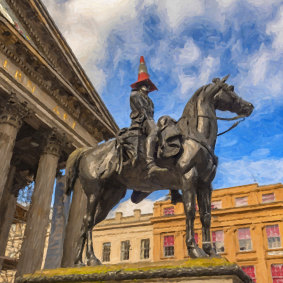
The Duke of Wellington, complete with traffic cone, in front of the Gallery of Modern Art, Glasgow.Credit: iStock
We’re in a small but perfectly formed Club Twin Room, which has bunks next to a sink and compact under-bed storage. There’s also a tiny separate toilet with an overhead shower that may require yogi-like flexibility to use. We count our blessings that we have minimal luggage and head to the dining car for a pre-bed tipple, joining a couple enjoying wine and cheese on stools by large windows and a sleepy family drinking hot chocolate in a booth. Meals and snacks can also be served in cabins; breakfast must be ordered the night before. It’s late, and overnight travel offers little to look at, so we’re soon slumbering, though I do wake hours later, spooked by the closeness of the roof above my head. Thankfully, the gentle rocking of the train soon sends me back to sleep.
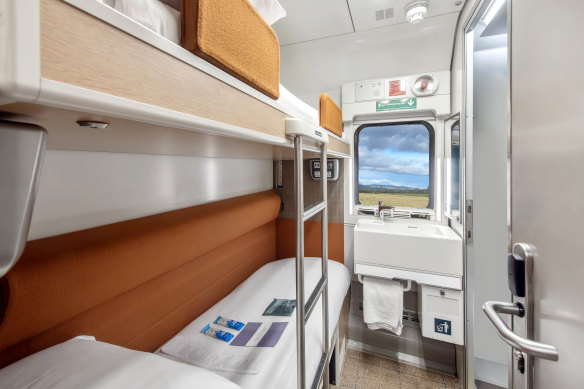
Caledonian Sleeper en-suite-room.
Early the next morning, we’re enjoying a full Scottish breakfast with black pudding (when in Rome) in the dining car when we realise we’re eating alone. “Where are we?” I ask a guard. “Euston,” she replies. “We’ve been in London for 20 minutes.”
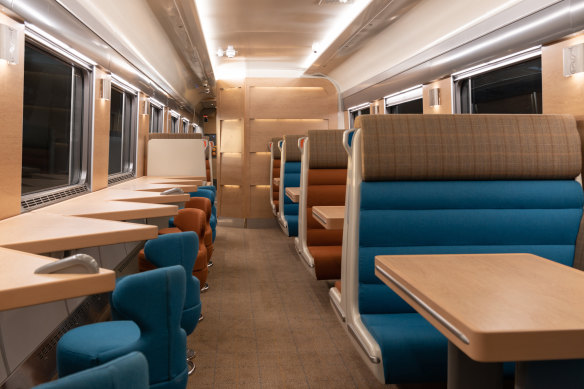
Caledonian Sleeper lounge carriage.
Side trip one – Victoria Station, London, to Cambridge
Eurail allows you to jump onto an unlimited number of trains on any day, so if you get a hankering to go somewhere, do it. We’re keen to take the 90-minute train to historic, hallowed Cambridge, where I once lived for a short time, to see if it’s changed. Has it? Of course not. The Mill riverside inn is there, the punts, and the Eagle (circa 1667), the pub where Francis Crick interrupted lunchtime drinkers in 1953 to announce that he and James Watson had discovered “the secret of life” – their plan for the structure of DNA. See visitcambridge.org
Side trip two – Waterloo Station, London, to Hampton Court
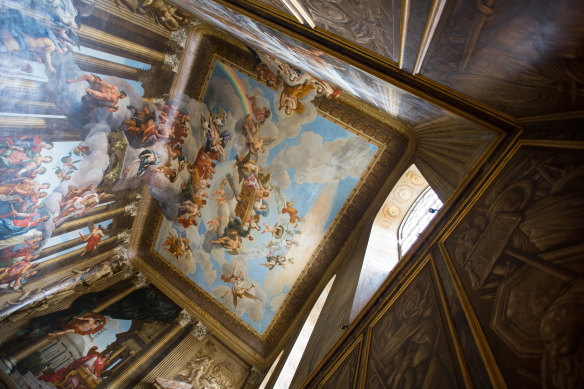
Ceiling above the King’s Staircase in the William III apartments, Hampton Court.Credit: iStock
The ghost of Catherine Howard, Henry VIII’s fifth wife, apparently runs screaming for her life through a gallery at Henry’s palace, Hampton Court. During our stay in London we decide to take a 35-minute train journey to see if we can see her for ourselves. If you don’t catch her or other apparitions, Hampton Court, built in 1514, has many other treasures, including original kitchens, stunning artworks and furnishings, a maze and sprawling gardens with deer and 300-year-old yew trees. We’re time travellers: deep in Tudor malevolence one minute, travelling with high-school kids swapping memes on the local train back to Waterloo the next. See hrp.org.uk
St Pancras Station, London, to Paris Gare du Nord on the Eurostar
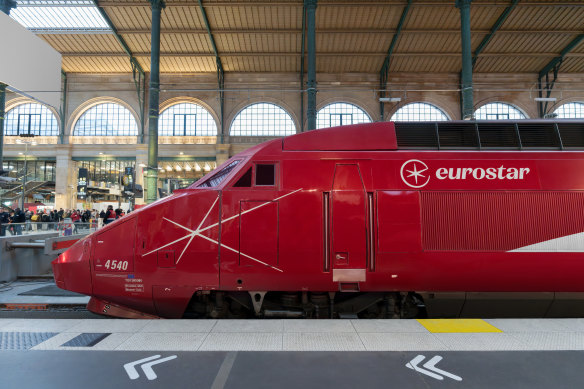
Eurostar, London to Paris.
Eurostar? Gold star. Despite having to deal with all that usual airport stuff on this leg – bag checks, passport control – (thanks, Brexit), the whole process is speedy, smooth, and even the immigration officers are chirpy (Australian passports are a hit). Airline chiefs need to get on board to see how real comfort is done: spacious seats, adjustable headrests, Wi-Fi, charging ports, water bottles in holders, magazines and even make-up mirrors. Our first-class tickets include lunch delivered via an airline-style trolley. The chicken stuffed with mushrooms or fresh quiche is served with couscous salad, real bread, good butter, dessert, bottled wine, linen napkins and proper cutlery. I sip shiraz, eat flaky pastry and let the green gallic scenery zipping past wash over me as an electronic ticker tape reminds all on board that “our passengers like to travel in tranquillity”. And they do.
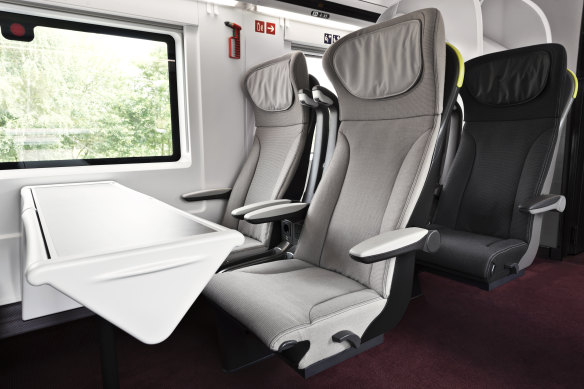
Eurostar … all the comforts.
Paris Montparnasse to San Sebastian, Spain, via Hendaye, SNCF fast train
After a few days in Paris, we’re hurtling through France with early morning, first-class tickets to Hendaye in the south-west, the last town on the Basque coast before Spain. Again, we have seats with something extra: all the comforts of the Eurostar plus footrests, phone pockets and even a coat hook. No lunch, though. We head to a buffet car to buy okay sandwiches and bad coffee (we’re still in France). Many leave the train at the French surf playground of Biarritz, but we are border-bound. The Hendaye-San Sebastian leg is not covered by Eurail, so we take a local Euskotren train. These run frequently, and the journey across the border to Spain is short and cheap (from €6/$9.60 a person; tickets available at a vending machine). We join office workers on their commute that passes gritty suburbia, then the grand buildings of Donostia, aka San Sebastian.
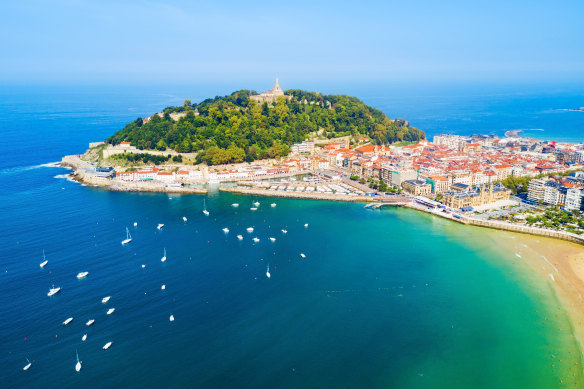
San Sebastian or Donostia.Credit: iStock
The final leg – San Sebastian to Barcelona, RENFE fast train
Loading
The trains in Spain run mainly on … time. “I’ll always pick a train over flying,” says a young Canadian backpacker who has spent months riding the rails through Europe. We’re chatting during our last Eurail trip on a RENFE high-speed train from San Sebastian to Barcelona. He says a rail pass enables him to experience “old-school” travel, seeing countries between each destination rather than flying over them.
“Flying is not that convenient when you factor in the standing around, plus trains are way greener, they give you more flexibility, and they’re rarely delayed. Sometimes it can be a bit more ‘exxy’ than flying in Europe, but it’s totally worth it.” We settle back in our seats and toast the passing countryside. We have to agree.
THE DETAILS
THE PASS
The Eurail Pass enables borderless rail travel across 33 countries, spanning 33,000 destinations. New routes are to be included in the network, including a fast train between Amsterdam and Brussels, starting pm December 15. The European Sleeper will also expand its overnight route, travelling from Brussels to Venice via The Netherlands and Austria, from February 5, 2025. See eurail.com
For Australian travellers, from November 26 to December 19, Eurail will cut 25 per cent from its passes under its “Journeys that make a difference” campaign donating €5 to Intrepid Travel’s non-profit, The Intrepid Foundation, for every pass sold in this period. Under the sale, a second-class Eurail Global Pass (seven travel days in one month, flexible, adult) will drop from $625 to $468.75, while a first-class Eurail Global Pass (three months continuous use, adult) will drop from $1991 to $1493.25.
The writer travelled to Europe at her own expense and rode the rails courtesy of Eurail.
